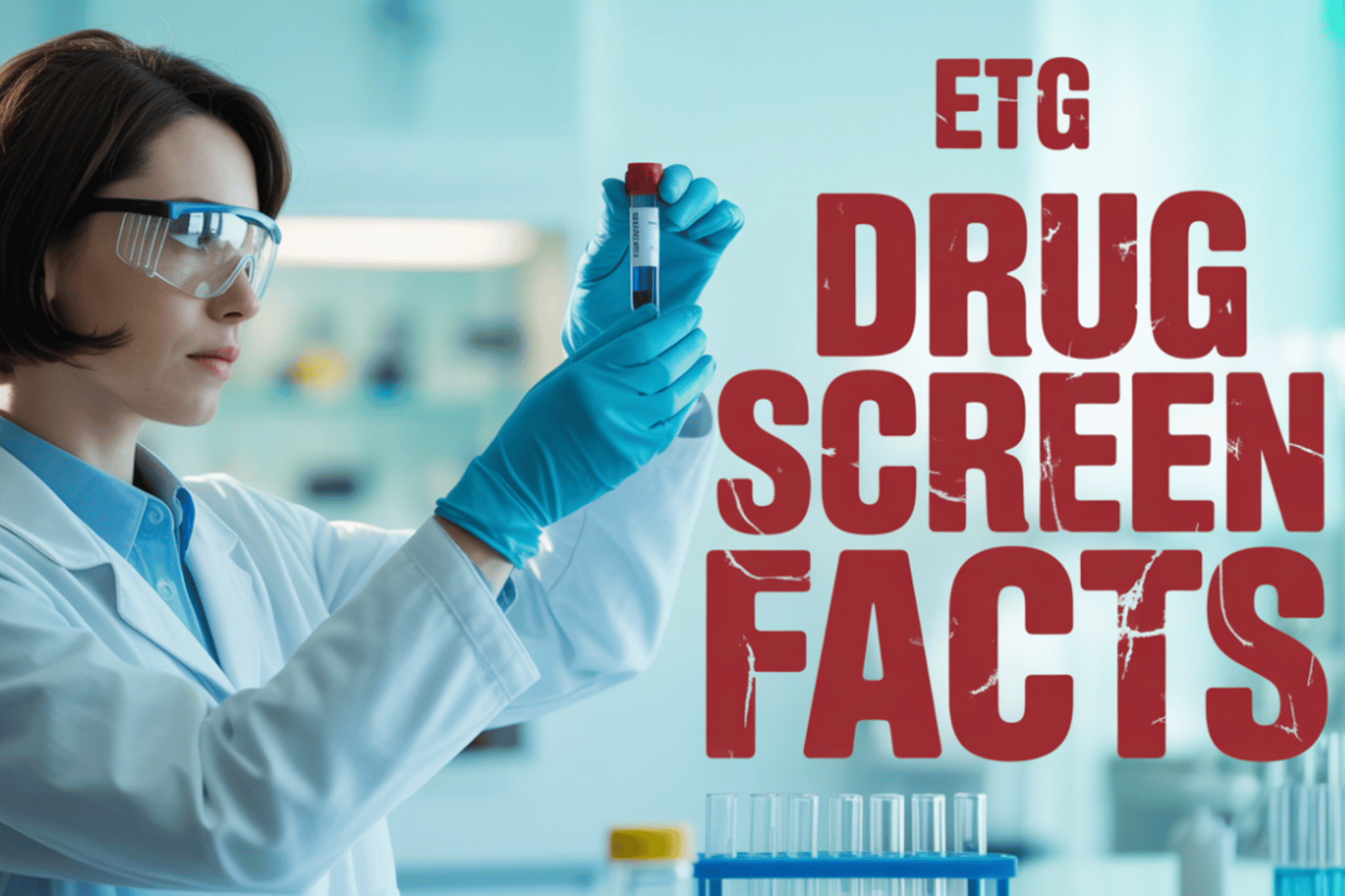What Is EtG on a Drug Screen?
What Is EtG on a Drug Screen? It’s a test that detects ethyl glucuronide, a marker used to identify recent alcohol consumption even after the effects have worn off. Ethyl glucuronide (EtG) is a metabolite of ethanol, the intoxicating component in alcohol. When a person drinks, ethanol is processed by the liver, forming EtG, which can be found in urine, blood, hair, and even saliva. This marker can be detected long after the alcohol itself is gone, making it a powerful tool in drug and alcohol screening.
What Is EtG on a Drug and Alcohol Test?
An EtG drug test is used to identify recent alcohol consumption. Rather than detecting current blood alcohol contentlike a breathalyzer or blood test, EtG tests track whether someone has recently had a drink, which is especially important for substance abuse monitoring, probation, drug court compliance, and treatment programs. EtG, along with ethyl sulfate (EtS), offers high sensitivity and specificity, making these tests highly reliable.
1. EtG Urine Testing
How It Works
In an EtG urine test, EtG is detected in a person’s urine for up to 80 hours or longer depending on their metabolism, level of consumption, and hydration status (water intake). These tests are often performed in a controlled laboratorysetting to ensure accuracy and prevent tampering.
Cutoff Levels & Interpretation
100 ng/mL: High sensitivity, can capture even incidental exposure to hand sanitizer or fermentationbyproducts.
500 ng/mL: Balanced threshold for detecting moderate to heavy drinking.
1,000 ng/mL: Typically reflects heavy alcohol use.
Common Uses
Urine EtG testing is frequently used in addiction treatment, mental health programs, and situations involving child custody, drug court, and probation monitoring.
2. EtG Hair Testing
How It Works
Hair testing allows for long-term detection of EtG and can reveal alcohol use for up to 90 days. While it’s less responsive to a single drink, it’s effective in identifying patterns of consistent consumption.
Limitations
Factors like glucose levels, hair treatments, blood type, and external contamination can affect results. EtG hair testing is less useful for detecting very light drinking but more useful for chronic users.
Result Interpretation by EtG Level
| EtG Level | Meaning |
|---|---|
| High (>1,000 ng/mL) | Heavy drinking, recent and likely intentional |
| Low (500–1,000 ng/mL) | Moderate consumption; review patient history and context |
| Very Low (100–499 ng/mL) | Possible incidental exposure; consider medication, hygiene products |
Interpreting test results should be done with the guidance of a physician or testing expert, especially when factors like nutrition, disease, or co-use of other substances (e.g., methamphetamine, amphetamine, phencyclidine, fentanyl, methadone, cotinine) may affect the outcome.
What Is an EtG Test Used For?
EtG testing is widely used to confirm abstinence or monitor compliance in:
Addiction recovery settings
Mental health and dual-diagnosis programs (e.g., for bipolar disorder)
Drug court and legal settings
Workplace and professional sobriety monitoring
Family court cases involving child custody
Lab Services
Urine Testing Services
Labs offer advanced urine testing with confirmatory methods like LC-MS. Each patient is monitored using protocols that reduce false positives and account for incidental exposure to ethanol-containing products.
Oral Fluid Testing Services
Though EtG isn’t commonly found in saliva, other forms of alcohol or blood testing may be done to assess ethanol presence in the system.
Support Services
Laboratories may provide:
Exam-style result reviews
Program tracking and documentation tools
Collection site setup and training
How Long Is Alcohol Detectable via Drug Testing?
| Test Type | Detection Time |
|---|---|
| Breathalyzer | 4–24 hours |
| Blood test | 12–24 hours |
| Urine (EtG/EtS) | Up to 80 hours, sometimes 5 days |
| Hair testing | Up to 90 days |
| Saliva | Up to 48 hours |
EtG detection provides a much longer window than traditional ethanol testing, especially when combined with ethyl sulfate and phosphatidylethanol (PEth), another alcohol metabolite that can identify long-term use.
What Factors Affect Alcohol Detection Time?
Amount and frequency of drinking
Personal metabolism and liver health
Underlying disease, such as diabetes or liver damage
Type of medication taken, including over-the-counter drugs
Co-ingestion of other substances like methadone, phencyclidine, or fentanyl
Use of hand sanitizer, perfumes, or household products containing ethanol
Nutritional status, hydration (water), and hormone levels
Exposure to fermented foods, wine, or kombucha
Conclusion
EtG testing is a powerful tool for detecting recent alcohol use across a variety of settings. With the ability to detect even trace amounts of ethyl glucuronide, this test helps maintain accountability in substance abuse treatment, probation, child custody, and drug court environments. Understanding the roles of metabolism, medication, and environmental exposure is key to accurate interpretation.
Whether you’re a patient, physician, or program manager, EtG testing provides valuable insights into sobriety, addiction recovery, and public safety efforts. Combined with tools like urine tests, blood tests, and hair analysis, EtG testing continues to shape the future of comprehensive drug and alcohol monitoring.
FAQs
1. What is EtG on a drug screen used for?
EtG on a drug screen is primarily used to monitor recent alcohol consumption by detecting ethyl glucuronide, a metabolite of ethanol. This type of test is commonly used in substance abuse treatment programs, drug court, probation monitoring, child custody cases, and workplace compliance settings where abstinence from alcohol is required. It provides a longer detection window than traditional alcohol testing methods.
2. How long does alcohol stay detectable in an EtG test?
The detection window for EtG varies based on the amount of alcohol consumed, metabolism, and the sensitivity of the test. In urine, EtG is typically detectable for up to 48 to 80 hours after drinking, and in some cases, up to 5 days. In hair testing, EtG can reveal patterns of alcohol use over a period of up to 90 days, making it ideal for identifying long-term or chronic alcohol consumption.
3. Can you test positive for EtG from using hand sanitizer or mouthwash?
Yes, it is possible to receive a low-level positive EtG result due to incidental exposure to ethanol-containing products such as hand sanitizers, mouthwash, or even fermented foods. These products contain small amounts of alcohol that can be absorbed through the skin or mucous membranes. For this reason, labs use specific cutoff levels to help distinguish between true alcohol consumption and environmental exposure.
4. What’s the difference between a breathalyzer and an EtG test?
A breathalyzer measures current blood alcohol content (BAC) and is typically used to assess immediate impairment, such as in DUI stops or workplace incidents. In contrast, an EtG test identifies ethyl glucuronide—a metabolite left behind after alcohol has been processed by the body. This allows EtG tests to detect alcohol use long after the effects have worn off, making them more suitable for monitoring sobriety over time.








